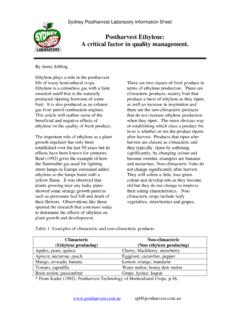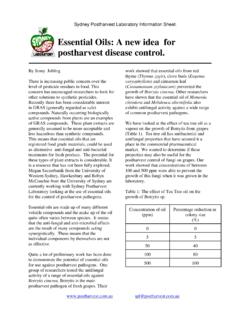Transcription of Correct cool chain management is essential for all fruit ...
1 Sydney Postharvest Laboratory Information Sheet. Correct cool chain management is essential for all fruit and vegetables. By Jenny Jobling Cool chain management is essential for preserving the harvested quality of fresh produce. Effective cool chain management begins on the farm and ends in the refrigerator at home. The cool chain begins by cooling the fruit after harvest and holding it at the best possible temperature while it is packed, stored and transported from the orchard to the retail market and then stored properly in the home. Unfortunately there are often many breaks along the way.
2 These breaks have an additive effect on reducing the potential shelf life of a product. For example, some cultivars of apples ripen as much in 1 day at 21oC as they would in 10 days at 1oC. This illustrates how even short breaks in the cool chain can have very significant effects on reducing the shelf life and quality of fresh produce. Any effort to reduce the breaks in the cool chain will have a positive effect on optimising the shelf life and quality of fresh produce. Temperature management Temperature management is one of the most important factors affecting the quality of fresh produce. There is an optimum storage temperature for all products. There are many references available that outline the ideal temperature and storage conditions for a range of fresh products.
3 For example, Optimal Fresh (2001) is a computer database program that outlines the optimum storage conditions for over 1200 fruit , vegetables and flowers. Optimal Fresh will shortly be released by CSIRO Publishing. The ideal temperature often depends on the geographical origin of the product. Tropical plants have evolved in warmer climates and therefore cannot tolerate low temperatures during storage. Most fruits or vegetables from plants from tropical regions must be stored above 12oC. This is in contrast to plants that have evolved in temperate, cooler climates that can be stored at 0oC. Precooling Precooling is the first step in good temperature management . Rapid cooling after harvest has been clearly shown to prolong the shelf life of freshly harvested produce.
4 During busy harvest times, it is important to have practical systems in place to minimise the amount of field heat accumulating in harvested fruit , as well as having an efficient system for removing that heat at the cool store. Most storage rooms designed for holding produce under refrigeration do not have the refrigeration capacity, or the air movement needed for rapid cooling. Therefore precooling must be a separate operation using special equipment. Precooling can be done using several methods including hydrocooling, vacuum cooling and forced air cooling. The choice of cooling method depends largely on the commodity and the cost benefit associated with it. Maintaining the cool chain Once the product is cooled to the desired temperature, the next step is to keep it cool.
5 It is important that there is adequate airflow and circulation within a storage room or refrigerated Sydney Postharvest Laboratory Information Sheet. truck. Poorly stacked or arranged bins or pallets can prevent airflow as the air will follow the path of least resistance, this causes the cold air to short circuit so that there is uneven cooling within a load or room. Uneven cooling will cause inconsistent product quality within the storage room. If the same commodity is routinely stored in a coolroom then lines can be painted on the floor so that the bins are arranged correctly to ensure Correct air flow and cooling.
6 The other important management procedure is to routinely check the air temperature inside the coolroom with a hand held thermometer. It is important to check different areas of the room to ensure the air flow is adequate. If the difference between the return and delivery air exceeds this is an indication that there isn t sufficient air flow in the coolroom and that the product is not being cooled efficiently. Why is Temperature management Important? Maintaining the cool chain is important for several reasons, all of which relate to maintaining product quality. For example, temperature has a direct effect on the respiration rate of the product and this is an indication of the rate of deterioration of the product.
7 Temperature also affects the rate of growth of postharvest rots. If the cool chain is maintained, both these factors can be slowed down and the shelf life can be extended and quality maintained. 1. Temperature, Respiration Rate and Shelf Life Figure 1 illustrates the relationship between the respiration rate of fruit and vegetables and temperature. For every 10oC increase in temperature the rate or respiration is roughly doubled or even trebled. For example an apple held at 10oC ripens and respires about 3 times as fast as one held at 0oC. This increase in respiration has a direct impact on the shelf life of fresh products. The storage life of commodities varies inversely with the rate of respiration.
8 Products with a high rate of respiration generally have a shorter shelf life than those with a lower rate of respiration. The relationship between respiration rate and temperature for peaches and asparagus05010015020025030005101520 Storage temperature oCRespiration rate (mg CO2/kg/hr)PeachAsparagus Figure 1. (Adapted from Hardenburg et al., (1986). The Commercial Storage of Fruits, Vegetables an Florist and Nursery Stocks USDA Handbook 66.) Sydney Postharvest Laboratory Information Sheet. The relationship between shelf life and storage temperature for stone fruit and asparagus01020304005101520 Storage temperature oCShelf life (days)Stone fruitAsparagus Figure 2.
9 (Adapted from Evans, B. (1996). Keeping your cool a quest for quality . Primary Industries SA and Hardenburg et al., (1986). The Commercial Storage of Fruits, Vegetables an Florist and Nursery Stocks USDA Handbook 66.) Figure 2 illustrates how the shelf life of products is affected by temperature. The lower the storage temperature the longer the shelf life. It is important to note that there is a significant improvement in shelf life by storing products at 0oC compared to 3 or 5oC. The storage life of products can be adversely affected by storing them at the wrong temperature. Asparagus is chilling sensitive and so the shelf life is actually reduced by storing it at 0oC as the optimum storage temperature is 2oC.
10 It is important that chilling sensitive products are stored at the Correct temperature, as chilling injury will make them unsaleable. Correct temperature management is also important for the consumer as well. For example most people know that bananas are chilling sensitive as they go black if they are stored in the refrigerator. Tomatoes shouldn t be stored in the refrigerator either. Tomatoes are also chilling sensitive and will not develop their full flavour if low temperatures have damaged them. It is possible in a limited way to predict the shelf life of a particular crop after exposure to different temperatures and storage atmospheres. With better development of our understanding of this process, it should be possible to give an accurate prediction of outturn condition after storage and exports.










